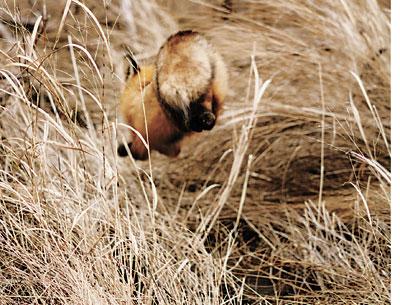A Malodorous Harbinger

Skunk cabbage, Symplocarpus foetidus, is a plant of the Northern Hemisphere and a species that occurs throughout most of North America except for in the South and West. A flowering plant in the Jack-in-the-pulpit family, it is one of the first plants to flower each year and thus is a true harbinger of spring. The second half of its scientific name refers to its fetid smell, not unlike the effluvia emitted by a defensive skunk or the scent a red fox uses to mark its territory.
It also occurs in eastern Asia, suggesting that it came here from there, or came there from here by way of Beringia, the land bridge across the Bering Strait connecting Siberia with Alaska over which early Mongolians traveled to North America during the last ice age, about 15,000 years ago.
In part of its range, its malodorous habits give it another name, polecat weed. In California, Oregon, and Washington, it is replaced by a look-alike, yellow skunk cabbage, but just like our local one, you note its presence before you come upon it. It has a similar skunky odor. The flowers, on the other hand, are sweet smelling, and when they are the only blooming flower in town early emerging honeybees frequent them. However, it was a surprise to me when I discovered by way of a friend that deer browse on them. If the plant were not a perennial, that would be a problem, but it is able to survive such foraging and bloom again the next year.
In our area, skunk cabbage sends up its leaves and begins to flower when the garden daffodils, crocuses, and hyacinths are still waking up. These last are somewhat frost tolerant, but not to the degree that the skunk cabbage is. Once it spreads it unfurls its leaves as early as the first week in February. Let it snow, let it snow, let it snow, even freeze, it’s a survivor. It’s one of those few native plants that has an antisfreeze that keeps it going through bitter cold.
Maybe, that’s what I tasted when I put a handful of the yellow skunk cabbage in my mouth to demonstrate to my Chemeketa Community College biology class in Oregon in 1972 that it would make a nice salad. One bite and I couldn’t open my mouth for five minutes. It was as astringent as alum. Like the deer, I should have tried the flowers. I might have gotten an A instead of an F for my demonstration.
If prepared properly, skunk cabbage is quite edible. In their “Flora of the Northeast,” Dennis Magee and Harry Ahles provide a recipe. To paraphrase, the root or rhizome is edible after peeling, cutting into thin slices, and drying for six months. The same applies to the young leaves, when tightly rolled, cut up, and dried for six months. In either case, for those hikers and campers who are very hungry, the recipe won’t be of much use. The two authors also say that powder made from the dried rhizomes can be used to make a tea or applied to wounds to dress them, again, not much use to a thirsty guy in a swamp or one who has just cut his hand on a bull briar.
They must exude a plant pheromone, as well, one that keeps most other plants from growing in their midst as they form a tight carpet which can cover more area than your living room. The foul odor may serve as a deterrent to some, an attractant to others, those organisms that would feed on the flowers, the pollen, or the seeds. In terms of looks, skunk cabbages are not unattractive. Their leaves are variegated with purples, greens, and yellows. They would go nicely in one of those rain gardens the greenies are heralding for catching roof and lawn runoff and removing its chemicals.
I don’t know anything about propagating them. Both the rhizomes and seeds may need the right soil mix and a special growth environment. Vicki Bustamante, who is able grow almost every local native plant species from a seed, cutting, or other propagule, is going to try. It may be easier to grow them than eat them. One shouldn’t have to wait six months to judge the outcome.
